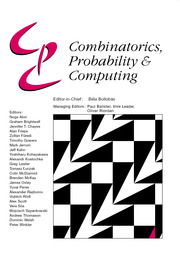Crossref Citations
This article has been cited by the following publications. This list is generated based on data provided by Crossref.
Chen, Xi
Papadimitriou, Christos
and
Peng, Binghui
2022.
Memory Bounds for Continual Learning.
p.
519.
Assadi, Sepehr
2023.
Recent Advances in Multi-Pass Graph Streaming Lower Bounds.
ACM SIGACT News,
Vol. 54,
Issue. 3,
p.
48.
Qin, Ya
Hashim, Siti Rahayu Mohd.
and
Sulaiman, Jumat
2023.
A new distance measure and corresponding TOPSIS method for interval-valued intuitionistic fuzzy sets in multi-attribute decision-making.
AIMS Mathematics,
Vol. 8,
Issue. 11,
p.
26459.
Chatterjee, Prayosi
and
Seikh, Mijanur Rahaman
2024.
Evaluating municipal solid waste management with a confidence level-based decision-making approach in q-rung orthopair picture fuzzy environment.
Journal of Industrial Information Integration,
Vol. 42,
Issue. ,
p.
100708.
Chatterjee, Prayosi
and
Seikh, Mijanur Rahaman
2025.
Decision Making Under Uncertainty Via Optimization, Modelling, and Analysis.
Vol. 558,
Issue. ,
p.
23.
Seikh, Mijanur Rahaman
and
Chatterjee, Prayosi
2025.
Sustainable strategies for electric vehicle adoption: A confidence level-based interval-valued spherical fuzzy MEREC-VIKOR approach.
Information Sciences,
Vol. 699,
Issue. ,
p.
121814.
Fischer, Orr
Oshman, Rotem
Rosén, Adi
and
Roth, Tal
2025.
Structural Information and Communication Complexity.
Vol. 15671,
Issue. ,
p.
281.
Chatterjee, Prayosi
and
Seikh, Mijanur Rahaman
2025.
Neutrosophic Paradigms: Advancements in Decision Making and Statistical Analysis.
Vol. 435,
Issue. ,
p.
101.
Liu, Yupan
2025.
Quantum state testing beyond the polarizing regime and quantum triangular discrimination.
computational complexity,
Vol. 34,
Issue. 2,
Chatterjee, Prayosi
and
Seikh, Mijanur Rahaman
2025.
Mathematics and Computer Science for Real‐World Applications.
p.
67.




